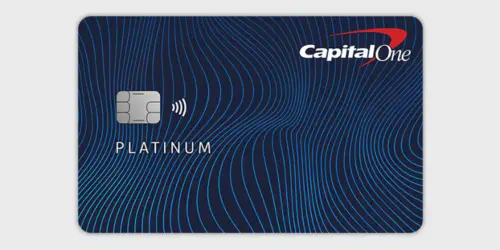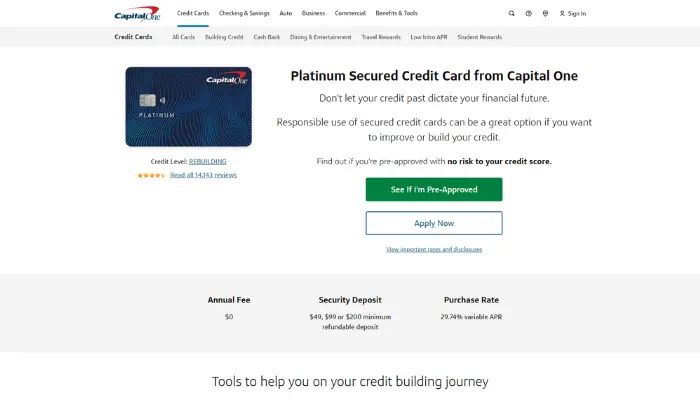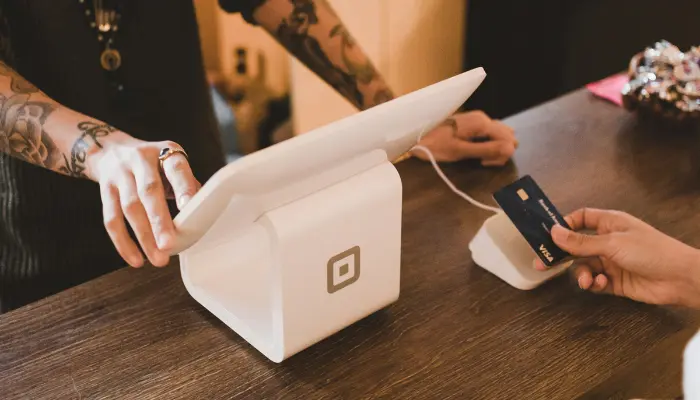If you’re starting from scratch with credit—or rebuilding after a few bumps—the Capital One Platinum Secured is that basic, reliable card that does what it promises: it helps you build credit history with no annual fee and a refundable security deposit.
It’s not a rewards or premium card, but it’s steady, predictable, and, used the right way, becomes a bridge to higher limits and even an upgrade to an unsecured card later.
Capital One highlights three things people love: $0 annual fee, no foreign transaction fees, and a minimum refundable deposit (commonly $49, $99, or $200) that gets you started with at least a $200 credit line.
What “secured” means—and who this card is for
A “secured” card uses a security deposit as collateral. It’s not a prepaid card—you use it like any regular credit card on the Visa/Mastercard network, and your payment history gets reported to the three major credit bureaus (Experian, Equifax, and TransUnion).
That reporting is what actually builds your credit over time. With the Platinum Secured, Capital One also reviews your account for credit-line increases as you show responsible use, sometimes without needing an additional deposit.
This card is an easy fit for:
-
People who have no credit history in the U.S.;
-
Anyone with a low score who needs a fresh start;
-
Folks who want a safe, predictable way to learn credit without surprise fees.
Your security deposit: how it works (and why it’s not “lost money”)

Capital One uses deposit tiers (often $49, $99, or $200) determined after reviewing your profile. With that deposit, you’ll get at least $200 in starting credit. If you want a higher initial limit, you can deposit more (up to the cap they allow).
Two common ways to get your deposit back:
-
Upgrade: if you use the card responsibly, Capital One may upgrade you to an unsecured product and refund your deposit.
-
Close the account: if you close the card with no balance due, Capital One refunds your deposit.
Think of the deposit less like a fee and more like a temporary, refundable stake in your own credit journey.
Fees, APR, and other costs you should know
-
Annual fee: $0. Great if you want to start with no fixed cost.
-
Foreign transaction fee: $0. Capital One is known for not charging foreign transaction fees on its consumer credit cards, which makes life easier for travel and international purchases.
-
APR: variable and generally high for this category. The golden rule: don’t carry a balance. Pay statements in full to avoid interest.
Turn on Autopay for “Full balance,” and put 1–3 small, predictable charges (like streaming or a phone bill) on the card. Keep utilization low (ideally under 10–20%) so your score trends in the right direction.
Pre-qualification vs. approval: soft vs. hard inquiry
Capital One lets you pre-qualify online in minutes. That’s a soft inquiry—it does not affect your credit score. If you then submit the actual application, that usually triggers a hard inquiry, which can temporarily nudge your score down a bit (normal and expected).
Key points:
-
Pre-qualification helps you gauge your odds without score impact;
-
Submitting the real application typically means a hard pull;
-
Avoid applying for several cards back-to-back—multiple hard pulls cluster together and can make approvals harder.
How to apply (step-by-step)
-
Check pre-qualification: go to Capital One’s site and see what they can offer you (soft pull only).
-
Submit your application: if you proceed, expect a hard inquiry as part of the approval process.
-
Pay your deposit: once approved, you’ll have a window (often up to 35 days) to complete your required minimum deposit. Capital One typically lets you fund in parts until you hit the full minimum.
-
Receive and activate your card: use the app to activate, set up Autopay, and turn on transaction alerts.
-
Use with a plan: start with small, recurring charges and pay before the statement closes to keep your utilization low and your payment history flawless.
Starting limit—and how to grow it faster
-
How your limit is set: you begin with at least $200 after paying your minimum deposit. You can boost the starting limit by depositing more (up to Capital One’s allowed maximum).
-
Automatic reviews: Capital One may review your account for credit-line increases after months of responsible behavior (often around six months, though nothing is guaranteed).
What helps:
-
Utilization: aim for 5–20% of your limit; lower is better.
-
Payments: pay on time every time (consider paying before the statement closes to keep reported utilization extra low).
-
Avoid cash advances: they’re expensive and do nothing for your score.
-
No revolving balances: interest is the enemy when you’re trying to build credit.
Using the card abroad and for online purchases
If you travel or shop on international websites, Capital One’s $0 foreign transaction fee policy is a genuine money-saver—many other issuers still charge around 3%. That makes the Platinum Secured a stress-free companion for trips, international subscriptions, or occasional overseas purchases.
Travel pro tips:
-
Some banks don’t require “travel notices” anymore, but it doesn’t hurt to use the app if you’re going off the beaten path.
-
If a terminal offers to charge you in USD via Dynamic Currency Conversion (DCC), decline it and pay in the local currency—merchants bake in poor exchange rates with DCC.
-
Always carry a backup payment method when traveling.
Benefits and useful tools
-
$0 fraud liability and real-time security alerts;
-
Instant card lock in the app;
-
Virtual card numbers (via Eno) for safer online shopping;
-
CreditWise for ongoing credit monitoring;
-
No foreign transaction fees for international purchases.
It’s not a perks monster, but it covers the essentials for safety, control, and day-to-day convenience while you focus on credit growth.
Drawbacks you should weigh

-
No cash back or points: if you want rewards from day one, consider a secured card with cash back.
-
High APR (typical of starter/secured cards): don’t carry a balance.
-
Modest starting limit: can feel tight if you need a lot of purchasing power immediately.
-
Deposit ties up cash: it’s refundable, but it’s still money you can’t use elsewhere for a while.
None of these are deal-breakers if your primary goal is to build credit safely. They’re just trade-offs that come with the territory.
How to cancel (and make sure you get your deposit back)
If you’re moving on to a different card:
-
Pay your balance to $0 (including any pending transactions);
-
Close the account through the app or by phone;
-
Monitor the refund of your security deposit once everything is settled.
Do it in this order to avoid delays and to ensure you get every dollar of your deposit back.
Is it worth it?
If your goal is to build or rebuild credit with minimal hassle, the Capital One Platinum Secured is one of the simplest, most transparent routes: no annual fee, refundable deposit, no foreign transaction fees, credit-line reviews, and reporting to all three bureaus.
Use it with discipline (low utilization + full payments) and it becomes the perfect first rung on the ladder to higher limits—and, in time, an upgrade to an unsecured card.
